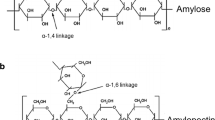Abstract
The aim of this study was to evaluate the use of the rapid visco analyser (RVA) instrument as a tool to sequentially analyse barley (Hordeum vulgare) malting varieties in order to visualise and interpret the effect of amylose and amylose complexes on its pasting properties. The RVA sequential profiles derived from the barley samples analysed showed a large peak (peak viscosity, PV) at the start of each cycle alternating with viscosity troughs during the hot paste viscosity cycle. The sequential cycles caused a slight decrease in both PV and (final) FV values in all barley varieties analysed. The addition of silver nitrate to the barley flour samples tends to slightly increase the PV value independently of the time of the analysis. The development of this methodology will provide with better tools to study starch pasting properties as well as to study the interactions between amylose and amylopectin with other compounds in various malting varieties.




Similar content being viewed by others
References
R. Agu, T. Bringhurst, J. Brosnan, Production of grain whisky and ethanol from wheat, maize and other cereals. J. Inst. Brew. 112, 314–323 (2006)
M.L. Bason, J.A. Ronalds, C.W. Wrigley, L.J. Hubbard, Testing for sprout damage in malting barley using the rapid visco analyser. Cereal Chem. 70, 269–272 (1993)
I.L. Batey, Interpretation of RVA curves, in The RVA Handbook, ed. by G.B. Crosbie, A.S. Ross (AACC International, St. Paul, 2007), pp. 19–31
J.N. BeMiller, Pasting, paste, and gel properties of starch-hydrocolloids combinations. Carbohydr. Polym. 86, 386–423 (2011)
J. Blazek, L. Copeland, Effect of monopalmitin on pasting properties of wheat starches with varying amylose content. Carbohydr. Polym. 78, 131–136 (2009)
J. Blazek, E.P. Gilbert, L. Copeland, Effects of monoglycerides on pasting properties of wheat starch after repeated heating and cooling. J. Cereal Sci. 54, 151–159 (2011)
R. Booth, M.L. Bason, Principles of operation and experimental techniques, in The RVA Handbook, ed. by G.B. Crosbie, A.S. Ross (AACC international, St. Paul, 2007), pp. 1–19
L. Copeland, J. Blazek, H. Salman, M.C. Tang, Form and functionality of starch. Food Hydrocolloids 23, 1527–1534 (2009)
D. Cozzolino, K. Allder, S. Roumeliotis, J. Eglinton, Feasibility study on the use of multivariate data methods and derivatives to enhance information from the rapid visco analyser. J. Cereal Sci. 56, 610–614 (2012)
D. Cozzolino, S. Roumeliotis, J. Eglinton, Relationships between starch pasting properties, free fatty acids and amylose content in barley. Food Res. Int. 51, 444–449 (2013)
D. Cozzolino, S. Roumeliotis, J. Eglinton, Relationships between fatty acids content and malt quality in barley grain, malt and wort. Cereal Chem. 92, 93–97 (2015)
M.R. Debet, M.J. Gidley, Three classes of starch granule swelling: influence of surface proteins and lipids. Carbohydr. Polym. 64, 452–465 (2006)
A.-C. Eliasson, Interactions between starch and lipids studied by DSC. Thermochem. Acta 246, 343–356 (1994)
I.D. Evans, A. Lips, Viscoelasticity of gelatinized starch dispersion. J. Texture Stud. 23, 69–86 (1992)
G. Fox, J. Visser, Th Skov, I. Meijering, M. Manley, Effect of different analysis conditions on rapid visco analyser malt viscograms in relation to malt of varying fermentability. J. Inst. Brew. 120, 183–192 (2014)
Z. Fu, J. Chen, S.J. Luo, Ch-M Liu, W. Liu, Effect of food additives on starch retrogradation: a review. Starch 2015(67), 69–78 (2015)
A. Guelpa, M. Bevilacqua, F. Marini, K. O’Kennedy, P. Geladi, M. Manley, Application of rapid visco analyser (RVA) viscograms and chemometrics for maize hardness characterisation. Food Chem. 173, 1220–1227 (2015)
V.J. Morris, Starch gelation and retrogradation. Trends Food Sci. Technol. 1, 2–6 (1990)
W.R. Morrison, R.F. Tester, C.E. Snape, R. Law, M.J. Gidley, Swelling and gelatinization of cereal starches. IV. Some effects of lipid complexed amylose and free amylose in waxy and normal barley starches. Cereal Chem. 70, 385–391 (1993)
Y. Song, J. Jane, Characterization of barley starches of waxy, normal, and high amylose varieties. Carbohydr. Polym. 41, 365–377 (2000)
H. Tang, H. Ando, K. Watanabe, Y. Takeda, T. Mitsunaga, Physicochemical properties and structure of large, medium and small granule starches in fractions of normal barley endosperm. Carbohydr. Res. 330, 241–248 (2001)
MCh. Tang, L. Copeland, Analysis of complexes between lipids and wheat starch. Carbohydr. Polym. 67, 80–85 (2007)
M. Zhou, N.J. Mendham, Predicting barley malt extract with a Rapid Viscoanalyser. J. Cereal Sci. 41, 31–36 (2005)
Acknowledgments
The authors thank technical staff of the Barley Quality Laboratory and the Barley Breeding Program, The University of Adelaide. This project (UA00126) is supported by Australia’s grain growers through their investment body the Grain Research and Development Corporation (GRDC), with matching funds from the Australian Government.
Author information
Authors and Affiliations
Corresponding author
Rights and permissions
About this article
Cite this article
Cozzolino, D., S, D. & J, E. The use of the rapid visco analyser (RVA) to sequentially study starch properties in commercial malting barley (Hordeum vulgare). Food Measure 10, 474–479 (2016). https://doi.org/10.1007/s11694-016-9326-z
Received:
Accepted:
Published:
Issue Date:
DOI: https://doi.org/10.1007/s11694-016-9326-z




